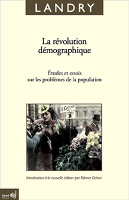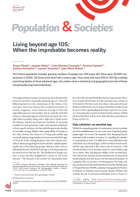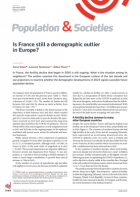
La révolution démographique
Études et essais sur les problèmes de la population
Collection : Classiques de l’Économie et de la population
2020, 280 pagesIntroduction to the new edition: A mix of science, moral teaching, and politics
Fabrice Cahen
Presentation (1st edition), Alain Girard
PART I
The demographic revolution
Demographic conditions in the past and now
Why mortality and natality fell so sharply
What the demographic revolution consists in
Where we are. Where we are going
The right way to assess the situation
What needs to be done
Depopulation and decadence
Introduction
Greece
Rome
The contemporary world
Conclusion
PART II
The three main population principles
The idea of progress
Maximum and optimum populations
New methods for studying changes in population
[The demographic revolution: studies and essays on problems of population] (re-edition), Adolphe Landry
First published in 1934, this work lays out Landry’s theory of demographic regimes and announces what would become the theory of demographic transition, a key stage in a country’s population development.
A politician in the Radical-Socialiste party, Adolphe Landry was born into an important family in Corsica and became interested in population growth quite early in life.
La Révolution démographique, described by Alain Girard in his preface to the 1982 re-edition as “a work of science that has not been contradicted by the march of time,” presents Landry’s theory of the three demographic regimes. In the earliest, or “primitive,” regime, demographic growth and subsistence were closely linked and mortality was high. The third, contemporary regime is characterized by an alliance between economic and social progress and family birth control. Landry then posits an intermediate regime which he called the “revolution,” understood to guarantee the shift from the primitive to the contemporary one, which are radically different from each other.
Landry’s methodical analysis of past demographic behaviors in Part I is highly insightful throughout. Understanding the past in order to envision the future is an essential, innovative theme in this work (cf. the chapter entitled “Where we are. Where we are going”). What he terms a country’s “maximum population” is neither a stable state nor an ideal to be attained; instead, it may vary over time with respect to a rational economic balance between wealth and population. Combining philosophical and moral thinking on progress and social well-being, Landry’s work belongs to the new humanist and sociological schools of thought that developed during the interwar period.
This re-edition features a preface by Fabrice Cahen that situates Landry’s thinking in the history and development of the discipline, enabling readers to discover or rediscover how the author’s trajectory fit into his particular time and context.
Adolphe Landry (1874-1956) graduated from France’s historic elite teacher-training school, the École Normale Supérieure, where he earned the country’s highest-level lycée teaching qualification in philosophy/where he studied philosophy and earned a qualification as associate professor. He represented Corsica in the National Assembly and served as government minister several times during the Third Republic. His other works include a treatise on demography. After World War II Landry became president of the Haut Comité Consultatif de la Population et la Famille and the International Union for the Scientific Study of Population. He also headed INED’s Administrative Board.
Fabrice Cahen is a historian and INED researcher specialized in the history of reproduction and population policies in France from 1870 to 1970. His works include Gouverner les moeurs: La lutte contre l’avortement en France, 1890-1950 [Governing mores: the battle against abortion in France, 1890-1950], from INED Publications.








